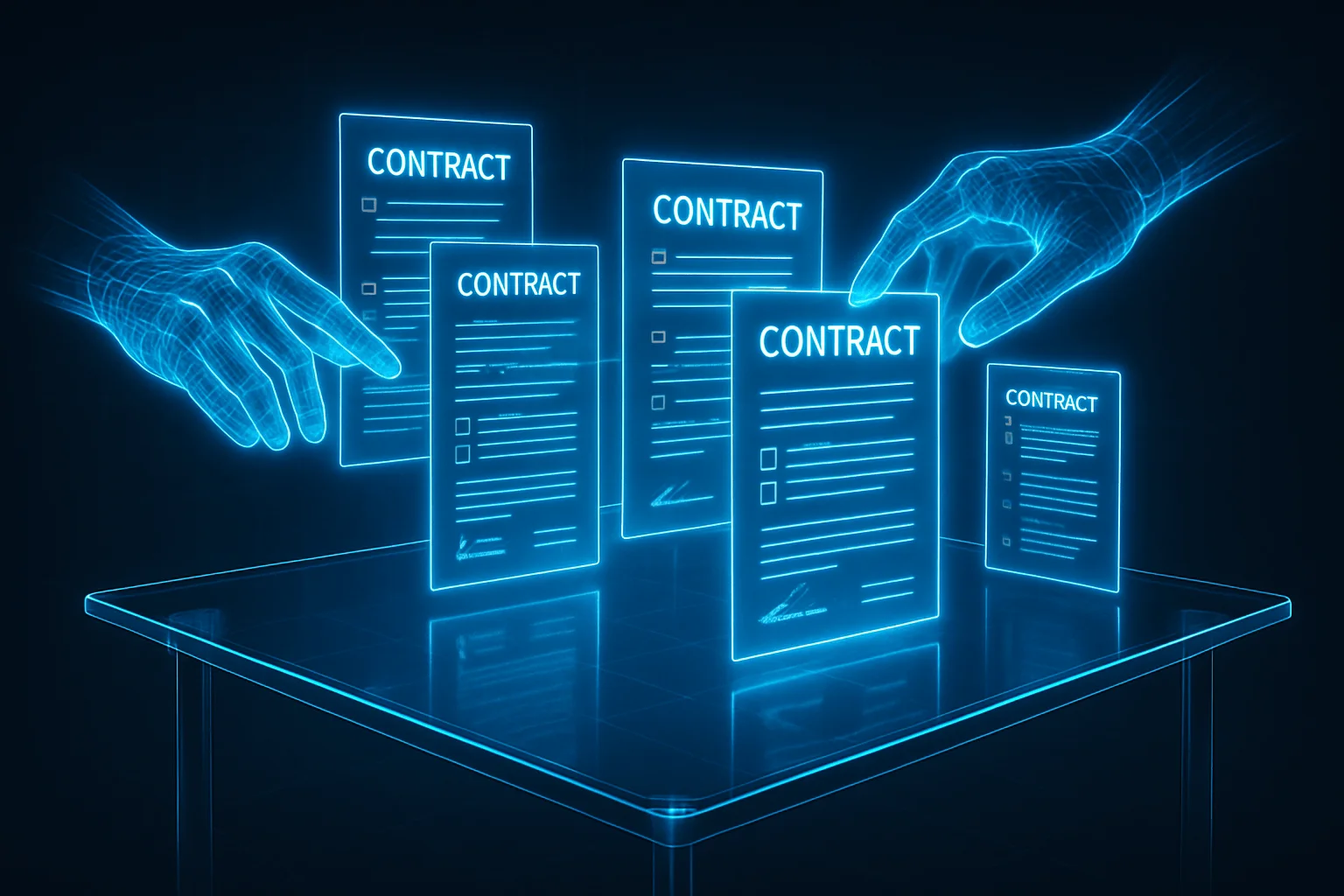Smarter Contract Handling with AI-Driven Document Automation Tools

Imagine spending hours pouring over contracts, only to realize a single missed clause could cost your business thousands. For today’s growth-focused companies, managing a constant influx of agreements isn’t just cumbersome—it’s a real risk to efficiency and compliance. That’s why organizations are turning to artificial intelligence to take the guesswork—and much of the manual labor—out of contract management. AI-powered document automation is redefining how businesses handle contracts, transforming slow, error-prone processes into streamlined, intelligent workflows. In this article, you’ll discover how these smart tools reduce bottlenecks, enhance accuracy, and free up valuable resources. We’ll explore the core benefits of automation, break down essential features to look for in leading solutions, and share actionable steps for integrating AI into your current contract handling processes. Whether you’re struggling with overflowing inboxes or aiming to scale without adding burdensome paperwork, you’ll gain practical insights to future-proof your document management strategy.
Automated Contract Creation and Customization
AI-powered document automation transforms the contract creation process into a seamless and error-resistant workflow, enabling growing businesses to generate tailored agreements in minutes rather than hours. By leveraging pre-built templates, dynamic data fields, and intelligent clause libraries, organizations drastically reduce manual drafting time and minimize the risk of inconsistencies or outdated language.
Steps to Implement Automated Contract Creation:
- Build or select contract templates covering key agreement types (e.g., NDAs, service agreements, sales contracts).
- Integrate data sources (like CRM or HR systems) to auto-populate party names, terms, and critical details.
- Use conditional logic to insert or remove sections based on contract type, value, or jurisdiction.
- Collaborate with legal teams to review and approve dynamic clause options for compliance.
Best Practice:
Collaborate cross-functionally with legal, sales, and operations teams to refine templates and approve AI-driven clauses, ensuring that business objectives and compliance are aligned at every step.
Scenario:
A rapidly expanding SaaS provider needs to issue dozens of sales contracts weekly. Instead of manually crafting each document, the sales team input deal specifics into a simple intake form. The AI engine assembles the relevant template, inserts negotiated commercial terms, and adjusts payment schedules based on customer segment. Legal reviews and approves only truly unusual variations, freeing up hours of repetitive drafting work and shortening sales cycles.
Intelligent Review and Risk Flagging
One of the most impactful AI advancements lies in rapid, intelligent contract review. Automation tools can parse lengthy agreements, flagging deviations from standards, missing clauses, or potentially risky language—all before signatures are collected. For growing businesses, this minimizes legal exposure and builds confidence in every executed document.
Workflow Steps:
- Upload incoming third-party or internally drafted contracts into the AI system.
- Automatically compare the contract text against your approved clause library and policy frameworks.
- Identify and annotate deviations, omissions, or novel clauses for legal review.
- Generate summary risk reports to highlight urgency and required stakeholder attention.
- Route flagged contracts to appropriate decision-makers for remediation or escalation.
Best Practice:
Regularly update your AI’s reference library with new legal guidance and lessons learned from previous contract negotiations, ensuring ongoing risk analysis stays current and relevant.
Scenario:
An e-commerce platform receives a partnership agreement from a potential logistics provider. Their AI tool instantly reviews the 15-page document, recognizing a missing confidentiality clause and an atypical indemnification term. These are highlighted for in-house legal, who negotiate corrections before the agreement is executed—avoiding a costly oversight that would have required lengthy amendments later.
Automated Approvals and Digital Workflows
As businesses grow, contracts require input and approval across departments—finance, legal, sales, and upper management. Manual routing is slow and error-prone. AI-driven automation platforms streamline this through intelligent routing, predefined approval chains, and configurable digital signatures, leaving an auditable trail and boosting accountability along the way.
Core Steps:
- Define routing rules based on contract value, counterparty, region, or type of agreement.
- Let AI assign contracts to the right reviewers—only involving legal teams or executives when thresholds are met.
- Notify stakeholders of required actions via integrated email or collaboration tools.
- Capture electronic signatures within the platform, enforcing version control throughout the process.
Best Practice:
Periodically review and optimize routing rules as your company grows to maintain efficiency, ensuring that low-risk contracts aren’t needlessly delayed by excessive approvals.
Scenario:
A marketing agency secures a new retainer contract. The system recognizes the client and contract value, automatically routing it first to finance for budget approval, then to legal for a clause check, and finally to the agency lead for final signature. Each party receives automated notifications, and the dashboard tracks progress—halving turnaround times and reducing misplaced contracts to zero.
Ongoing Compliance and Renewal Management
Contract management doesn’t end at execution. For a business scaling rapidly, missing renewal dates or failing to track compliance requirements can mean lost revenue or breached obligations. AI-document automation platforms proactively monitor contract repositories, trigger alerts, and surface actionable insights for responsible teams.
Steps in the Workflow:
- Index and categorize all executed contracts in a searchable digital repository.
- Set automated reminders for key dates—renewals, expirations, deliverable milestones, and renegotiation windows.
- Use AI to scan contracts for compliance requirements, such as insurance certificates or performance audits.
- Generate periodic compliance and renewal reports for contract owners and management.
Best Practice:
Assign clear ownership for each contract and align automated reminders with your business’s review cycles to ensure action is taken well before deadlines or compliance checkpoints.
Scenario:
A healthcare startup manages numerous supplier agreements, each with strict HIPAA compliance clauses and annual audit deadlines. Their AI-driven system sends timely alerts to the compliance officer and contract manager when an audit certificate is due or when a renewal window opens, ensuring documentation is submitted and contracts renegotiated or renewed proactively, rather than in a reactive rush.
Common Challenges
While AI-powered contract automation delivers significant benefits, organizations should be mindful of the following pitfalls to ensure adoption and effectiveness:
-
Data Silos and Incomplete Integration:
If your automation system doesn’t seamlessly connect with existing databases (like your CRM, HR, or finance platforms), you risk populating contracts with outdated or incorrect information. This not only erodes trust but can introduce costly errors requiring manual correction. -
Over-Reliance on Default Templates:
Too much faith in standard templates without periodic review can result in contracts that are outdated or not tailored to evolving business models and regulatory changes. Rigid templates may miss negotiation opportunities or expose you to hidden risks. -
Change Management and User Adoption Issues:
Even the best automation tools stumble if employees resist adoption. A lack of training, unclear roles, or poorly communicated benefits can slow implementation, leading teams to revert to legacy processes and stifling digital transformation.
Overcoming Challenges Quote:
“Successful contract automation hinges on continuous integration with business systems, regular template audits, and active change management. Make sure everyone understands not just the tool, but the why—and the results will follow.”
FAQs
Q1: How do AI-driven document automation tools ensure contract compliance with specific industry regulations?
A: Most advanced systems incorporate customizable clause libraries and conditional logic tied to jurisdiction or industry. Configure these to reflect your regulatory framework (e.g., GDPR for tech, HIPAA for healthcare). Additionally, schedule periodic reviews with legal experts so your AI’s compliance library is always up to date. Regular audits of executed contracts against these standards can help catch gaps early, and dashboards built into automation tools will surface ongoing compliance checkpoints for assigned owners.
Q2: Can these tools adapt to unique, negotiated agreements, or only standard contracts?
A: Modern AI contract automation platforms are highly flexible. While they excel at standardization, they also allow for custom clause insertion, negotiation tracking, and deviation flagging. For bespoke terms, the tool can alert legal and business stakeholders for manual review, while still handling 80-90% of the contract process automatically. Always ensure your workflows allow for “exceptions” so high-value or unusual deals get the attention they deserve.
Q3: What should businesses do to maintain security and confidentiality in automated contract workflows?
A: Choose platforms with robust access controls, end-to-end encryption, and audit trails. Configure user permissions so only authorized personnel can create, view, or modify sensitive agreements. Utilize built-in monitoring tools to detect suspicious activity or unauthorized access. Partner with IT to review compliance with your organization’s information security policies, and regularly test system vulnerabilities as business needs—and external threats—evolve.
Q4: How quickly can a growing business expect ROI from implementing AI-driven contract automation?
A: While every organization’s metrics vary, most see meaningful improvements within 3-6 months. Key drivers include reduced contract cycle time (often by 50% or more), fewer manual errors, and improved compliance tracking. For best results, set clear KPIs at the outset—like turnaround time, error rates, and stakeholder satisfaction—then monitor these monthly to measure and optimize your investment’s impact.
By adopting these AI-driven contract workflows and addressing common implementation pitfalls, growing businesses can dramatically enhance contract management, mitigate risk, and fuel sustainable, efficient scaling.
Embracing AI-powered document automation is no longer just a competitive edge—it’s a practical necessity for businesses eager to grow efficiently and securely. From reducing manual errors to accelerating approval cycles, the strategies discussed here put your organization in a stronger position to scale. As your next step, consider how automating your contract processes can free up valuable time and unlock new opportunities. Reflect on what would change if your team spent less time buried in paperwork and more time driving results. We’d love to hear your experiences or questions in the comments—let’s keep the conversation going. Don’t forget to share this article with fellow changemakers ready to step into the future of smarter contract handling!



